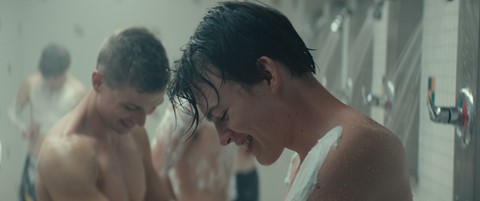“I don’t want to lump everyone into a handful of very binary categories,” says Keith Behrman, the director behind new movie Giant Little Ones
As Keith Behrman was making the final edits to his latest film, Giant Little Ones, he suddenly started to worry that the movie he’d spent the last six years making would now be completely irrelevant. “I thought, by the time we release this would all the kids be fine? Would homophobia would be a thing of the past?” Fortunately for the filmmaker – slightly less fortunate for, I don’t know, society as a whole? – homophobia is still holding steady. “I wouldn’t have felt great if we’d released it and people turned around and said, ‘So what? Why are we here?’ That would have been awkward,” says Behrman. “But at the same time, I was saddened to hear about what people are still struggling with. There’s more openness and more acceptance than when I was a teenager, but a lot of high-school students I spoke to said the film totally nailed it. That was a surprise to me.”

Giant Little Ones, which is released on February 3, tells the story of two teenage friends, Franky and Ballas, who swim, cycle, study and party in picturesque suburbia. The two boys – complete with their gaggle of jocks, band kids, eggheads and high-school crushes – while away the time by making plans to get laid, sipping slushies in the sun. So far, so predictable. That is, until the film takes a turn on the night of Franky’s 17th birthday, and an unexpected sexual discovery fundamentally upends Franky and Ballas’ relationship. At this point, most commercial movies might pivot down one of two familiar paths – a coming-out narrative which leaves one of the boys exiled for his being different, or a coming-out narrative where the protagonist realises defiant self-acceptance is the key to living a fulfilled gay life. Giant Little Ones does not blindly follow these tropes. “People want to give it a label, one reviewer wrote that’s it’s a coming-out film where nobody comes out. I thought that was so bizarre and frustrating,” says Behrman. “We’ve had a lot of films about people who define themselves and come to terms with who they are, they proudly accept their label and say ‘I am this’. I don’t see many stories where you don’t need to define, you just are.”
It’s this ambiguity, this refusal to clearly delineate the sexuality or gender identity of its core characters that sets Giant Little Ones apart. Where some writers or directors might be drawn to neat labelling, concluding the film with definitive answers about who each character is and how they define themselves, Behrman resists. He holds space for the fluidity of desire in a way that paints a much more authentic coming-of-age portrait. “The ending, sometimes people say, what’s happened? Is he with a guy, is he with a girl? It’s not really about that, it’s about the possibility of either ending. He’s gained his wholeness, rather than living with fear and constrained within the limits of our society.”
Behrman’s interest in probing the foggy greyness between definitions of straight, gay or bisexual comes from personal experience. “As I got older, there were some periods in my life where I thought am I attracted to a man? Is he attracted to me? Is he hitting on me? What does that mean?” For the director, not exploring those questions would mean suppressing a very natural impulse; it would be closing off what Behrman calls “a naturally occuring expansiveness”. That inquisitiveness, however, wasn’t without hesitation. “There was some fear about it, I had all of this homophobia ingrained, that I’d grown up with. I was also in a relationship with a woman at the time so that was complicated. Eventually, after experiences with both men and women, the black and white paradigm fell away. Any anxiety I had disappeared and I felt more whole because of that.”
While Giant Little Ones depicts a vagueness rarely represented in film, Behrman is conscious that any discussion about rejecting labels needs to be nuanced and carefully framed. We discuss the importance of queer people taking pride in our labels as a way to ensure visibility, as a way to foster safe spaces for marginalised groups. “I didn’t want to make a film that suggested how people should be, what’s valid or invalid,” he says. “Our identity is a spectrum, and I want Giant Little Ones to encourage people to make space, take a breath, so we can ask questions. What is your experience as a human being? What are your desires? Impulses? Attractions? What makes you feel alive and curious? We’re vastly complicated creatures, capable of so many different permutations. I don’t want to lump everyone into a handful of very binary categories.”
Giant Little Ones is available to download from February 3, 2020.
